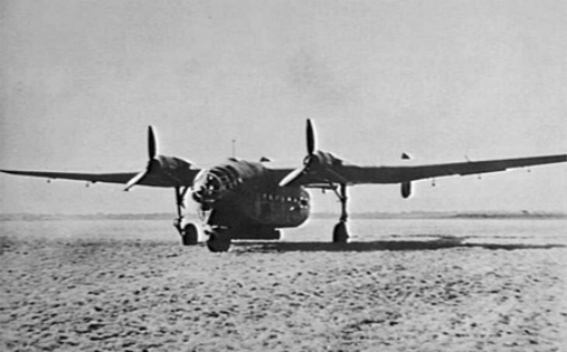
Production of the BMW 801 was insufficient to supply this new demand, and the Ar 232 was forced to use another engine. Eventually, the BMW Bramo 323 Fafnir nine-cylinder radial, itself weighing some 550 kg (1,210 lbs), from Focke-Wulf's Fw 200 land-based maritime patrol aircraft as an alternate powerplant choice was selected instead, as it was already in production and could meet requirements if the Ar 232 really did replace the Ju 52/3m in service.
The prototypes were far enough along that switching engines would have seriously delayed the program, so the first two were to be completed as the Ar 232A , and the third and a newly ordered fourth as the Ar 232B . The third and fourth prototypes (and all production aircraft) used four engines (in place of the two specified in the RLM specification) in order to provide the desired performance.


The first two prototypes, bearing the Stammkennzeichen alphabetic codes GH+GN and VD+YA respectively, started trials in early 1941. The first flight resulted in the collapse of the nose gear, but the twenty-two "millipede wheels" saved the aircraft from damage. A further ten pre-production machines were built, and were used operationally as the Ar 232A-0 while awaiting production versions. In general, the Ar 232 completely outperformed the Ju 52/3m. It carried roughly double the load over longer distances, operated from shorter runways and rougher fields if need be, and cruised about 70 km/h (44 mph) faster.
The Ar 232B program ran at the same time. With the quartet of 895 kW (1,200 hp) Bramo 323s replacing the twin BMW 801s, each Bramo 323 with its aforementioned 550 kg dry weight apiece; power increased from 2,386 kW (3,200 hp) to 3,580 kW (4,800 hp), solving the A model's problem of having little excess power in case of engine failure. This change also required the wing to be extended slightly, the span increasing just over 3 m in total. The extra weight of the Bramo nine-cylinder engines also moved the center of gravity forward, which was offset by stretching the cargo area rearward another meter, adding to the cargo capacity it could carry internally.
Two four-engined prototypes were ordered, the V3 and V4, and V3 first flew in May 1942. A further 10 were then ordered as the Ar 232B-0, and were used widely in an operational role. However, this was the only order for the design, as the Luftwaffe gave transport aircraft production a very low priority. Many of those produced were used by Arado to transport aircraft parts between its factories, and did not see front-line service.
Plans were also made to replace the outer wing sections and control surfaces with wooden versions to conserve aluminium. Originally to be known as the Ar 232C, the design dragged on and was later renamed the Ar 432. Plans were finally put into place to start production in October 1945, but the war ended without even a prototype being produced. Two even larger planned versions, the Ar 532 and the Ar 632, would have almost doubled the wingspan to 60m, as large as Germany's six-engined Bv 238 flying boat design, and added another two engines.
Two of the B-0s were captured by British forces at the end of the war. After test flights by Eric "Winkle" Brown , who gave the design excellent marks, they were used by the Royal Air Force on flights between England and Germany after the war
Variants
Ar 232 V1 & V2
Ar 232A prototypes and research aircraft, powered by two 1,193 kW (1,600 hp) BMW 801A/B engines.
Ar 232 V3 & V4
Ar 232B prototypes and research aircraft, powered by four BMW Bramo 323R-2 Fafnir engines.
Ar 232A - Pre-production aircraft used for operational trials, powered by two BMW801 engines, only ten built.
Ar 232B - The first production aircraft powered by four Bramo 323 Fafnir engines, only ten built, - as Ar 232B-0.
Ar 232C - A redesigned version using wood for outer wing sections and control surfaces.
Ar 432 - The planned production version of the Ar 232C, renamed.
Ar 532 - Planned enlarged six-engined version of the Ar 432.
Ar 632 - Planned enlarged six-engined version of the Ar 432.
Specifications Ar 232B
Crew: 4
Length: 23.52 m
Wingspan: 33.50 m
Height: 5.69 m
Wing area: 142.60 m²
Empty weight: 12,780 kg
Useful load: 4500kg
Max. takeoff weight: 21,150 kg
Powerplant: 4 × BMW Bramo 323R-2 Fafnir 9-cylinder radial engine, 895 kW (1,200 hp) each
Maximum speed: 308 km/h at 4,000 m
Cruise speed: 290 km/h at 2,000 m
Range: 1,062 km
Service ceiling: 6,900 m
takeoff in 200m possible Armament
Guns: 1 × 13 mm MG 131 machine gun mounted in the nose
1 × 20 mm MG 151/20 autocannon mounted in an Elektrische Drehlafette EDL 151 forward dorsal turret
1–2 × 13 mm MG 131 machine gun mounted in the rear position
Up to 8 × 7.92 mm MG 34 machine guns mounted in side windows when transporting infantry
Ei kommentteja:
Lähetä kommentti
Kaikenlaiset kommentit ovat tervetulleita.